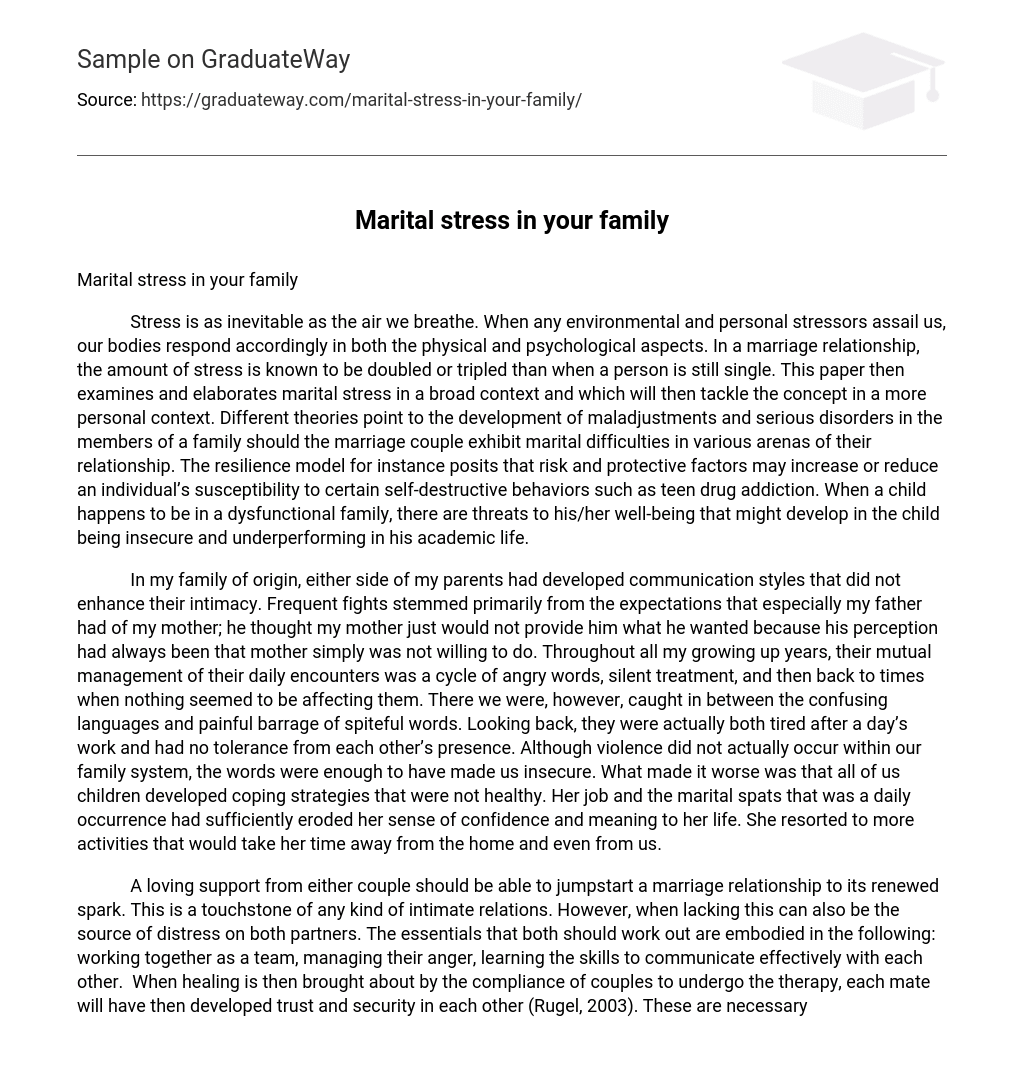Stress is as inevitable as the air we breathe. When any environmental and personal stressors assail us, our bodies respond accordingly in both the physical and psychological aspects. In a marriage relationship, the amount of stress is known to be doubled or tripled than when a person is still single. This paper then examines and elaborates marital stress in a broad context and which will then tackle the concept in a more personal context. Different theories point to the development of maladjustments and serious disorders in the members of a family should the marriage couple exhibit marital difficulties in various arenas of their relationship. The resilience model for instance posits that risk and protective factors may increase or reduce an individual’s susceptibility to certain self-destructive behaviors such as teen drug addiction. When a child happens to be in a dysfunctional family, there are threats to his/her well-being that might develop in the child being insecure and underperforming in his academic life.
In my family of origin, either side of my parents had developed communication styles that did not enhance their intimacy. Frequent fights stemmed primarily from the expectations that especially my father had of my mother; he thought my mother just would not provide him what he wanted because his perception had always been that mother simply was not willing to do. Throughout all my growing up years, their mutual management of their daily encounters was a cycle of angry words, silent treatment, and then back to times when nothing seemed to be affecting them. There we were, however, caught in between the confusing languages and painful barrage of spiteful words. Looking back, they were actually both tired after a day’s work and had no tolerance from each other’s presence. Although violence did not actually occur within our family system, the words were enough to have made us insecure. What made it worse was that all of us children developed coping strategies that were not healthy. Her job and the marital spats that was a daily occurrence had sufficiently eroded her sense of confidence and meaning to her life. She resorted to more activities that would take her time away from the home and even from us.
A loving support from either couple should be able to jumpstart a marriage relationship to its renewed spark. This is a touchstone of any kind of intimate relations. However, when lacking this can also be the source of distress on both partners. The essentials that both should work out are embodied in the following: working together as a team, managing their anger, learning the skills to communicate effectively with each other. When healing is then brought about by the compliance of couples to undergo the therapy, each mate will have then developed trust and security in each other (Rugel, 2003). These are necessary steps because long term stress between married couples, studies show, result to physical distress and detrimental to overall well-being. Physiological effects of marital stress to any of the couple include heart disease, e.g., atherosclerosis, usually because of the need to feel control (usually on the husband’s side) and feelings of hostility on the wife’s side (ABC News, 2006). Clinical depression may also result but children take the brunt of the couples’ stressful episodes and may usually cope with unhealthy ways and the risk of adopting maladjusted behavior is high. When either one of the parent may suffer Unipolar disorder for instance, this presents physiological, psychological, social and environmental threats for all the children. There is also the possibility that not all children will be adversely affected, however (Strengthening families, p.1).
In the light of these, the means of coping are perhaps crucial to emerging a healthy disposition in life. Whenever children grow up in a negatively oriented home, their hope lies in either parent who still has the presence of mind to handle their children well despite their background. Interventions are also the next line of defense in such situations.
Reference:
1. ______, 2005. “Marital Stress Affects the Hearts of Husbands and Wives Differently
Research Shows Strains of Marriage Take Toll Differently on Men and Women”
2. Rugel, Robert P, 2003. Treating Marital Stress, Support Based Approaches. Haworth press.
3. ______, Strengthening families. From risk to resiliency: Protective factors for children. Accessed September 20, 2007 <http://www1.nmha.org/children/risk.pdf.>





